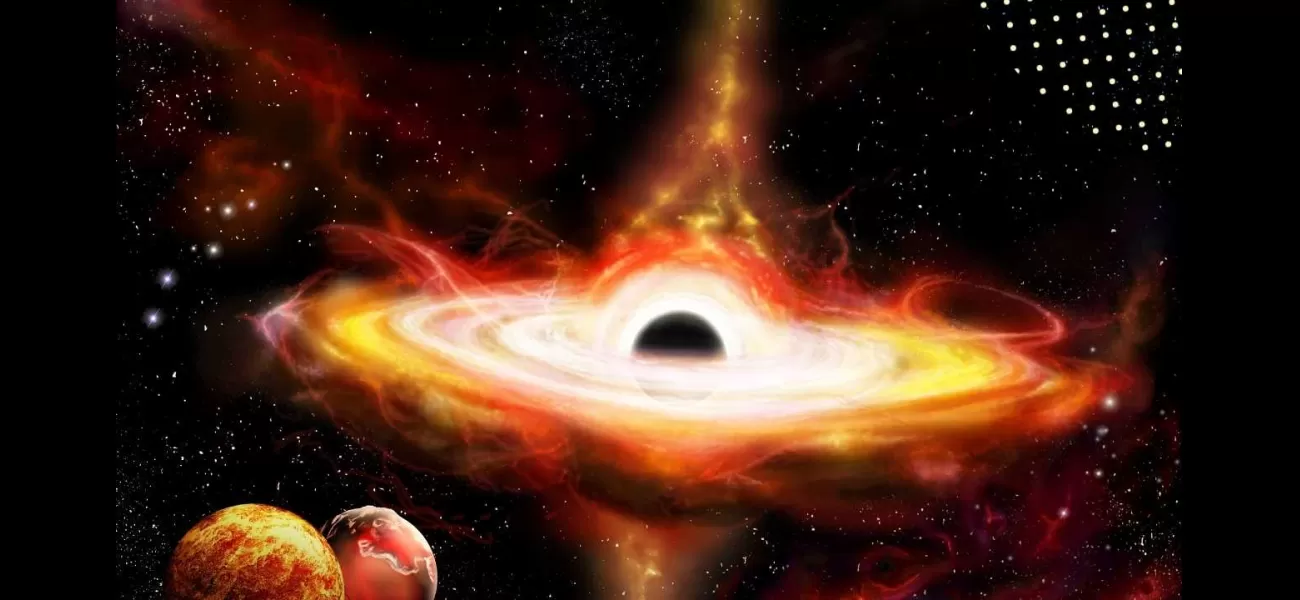A team of scientists discovers a potential record-breaking phenomenon: a black hole consuming a star on a daily basis.
"Scientists have discovered a celestial object 500 trillion times brighter than our sun, known as a quasar, which may be the brightest thing in the universe."
February 21st 2024.

Scientists have recently made an astonishing discovery - a celestial object that may be the brightest thing in the entire Universe. It's called a quasar, and it's truly unlike anything we've ever seen before. This quasar is a unique and fascinating phenomenon, with a black hole at its center that is growing at an incredibly rapid pace. In fact, it's consuming the equivalent of one whole sun every single day!
To put this into perspective, the quasar is a staggering 500 trillion times brighter than our sun. Just imagine that for a moment. And the black hole at its center? It's more than 17 billion times larger than our sun. This groundbreaking discovery was made by a team of scientists from Australia, who published their findings in the prestigious journal, Nature Astronomy.
Despite its small appearance in pictures, scientists believe that the quasar is an incredibly intense and dynamic place. Quasars are galactic cores where gas and dust fall into a supermassive black hole, creating a spinning disk that resembles a massive storm in space. This disk is made up of bright, swirling gas and other matter that the black hole has swallowed from nearby stars. It's like a massive cosmic hurricane, swirling around the black hole at its center.
Lead author Christian Wolf from the Australian National University describes the quasar as the most violent and energetic place in the entire universe. And he's not wrong. The European Southern Observatory first spotted the object, named J0529-4351, back in 1980 during a sky survey. However, they initially thought it was just a star. It wasn't until last year that they realized it was, in fact, a quasar - a super active and bright core of a galaxy. Further observations from telescopes in Australia and Chile's Atacama Desert confirmed this groundbreaking discovery.
One of the most exciting aspects of this discovery is that the quasar had been hiding in plain sight all this time, misclassified as a star. Priyamvada Natarajan from Yale University, who was not involved in the study, describes it as an "exciting" find. The team's observations and computer modeling have revealed that the quasar consumes the equivalent of 370 suns every year - that's about one sun per day! Additionally, they have determined that the black hole at its center has a mass of 17 to 19 billion times that of our sun. But there is still much more to learn about this extraordinary quasar, and more observations are needed to better understand its rapid growth.
The research was a collaborative effort between the ESO, the University of Melbourne, and the Sorbonne University in France. But what exactly are quasars and how do they work? Quasars, short for "quasi-stellar radio sources," are incredibly energetic and distant celestial objects. They appear as point sources of light and are among the most luminous objects in the universe. These powerful sources of energy are powered by supermassive black holes at the centers of galaxies.
As material falls into these black holes, it forms a hot, rapidly rotating disk known as an accretion disk. The intense gravitational forces and friction within the disk generate immense amounts of energy, releasing radiation across the electromagnetic spectrum. This includes everything from radio waves to X-rays. Quasars were more common in the early universe and are believed to play a significant role in the evolution of galaxies and the structure of the universe.
In summary, the recent discovery of the quasar J0529-4351 is a remarkable achievement in the world of astronomy. This celestial object, 500 trillion times brighter than our sun, has been hiding in plain sight for decades, masquerading as a star. But thanks to the diligent work of scientists and advanced technology, we now have a better understanding of this incredible and powerful phenomenon. With more research and observations, we will undoubtedly uncover even more secrets about the mysterious and fascinating world of quasars.
To put this into perspective, the quasar is a staggering 500 trillion times brighter than our sun. Just imagine that for a moment. And the black hole at its center? It's more than 17 billion times larger than our sun. This groundbreaking discovery was made by a team of scientists from Australia, who published their findings in the prestigious journal, Nature Astronomy.
Despite its small appearance in pictures, scientists believe that the quasar is an incredibly intense and dynamic place. Quasars are galactic cores where gas and dust fall into a supermassive black hole, creating a spinning disk that resembles a massive storm in space. This disk is made up of bright, swirling gas and other matter that the black hole has swallowed from nearby stars. It's like a massive cosmic hurricane, swirling around the black hole at its center.
Lead author Christian Wolf from the Australian National University describes the quasar as the most violent and energetic place in the entire universe. And he's not wrong. The European Southern Observatory first spotted the object, named J0529-4351, back in 1980 during a sky survey. However, they initially thought it was just a star. It wasn't until last year that they realized it was, in fact, a quasar - a super active and bright core of a galaxy. Further observations from telescopes in Australia and Chile's Atacama Desert confirmed this groundbreaking discovery.
One of the most exciting aspects of this discovery is that the quasar had been hiding in plain sight all this time, misclassified as a star. Priyamvada Natarajan from Yale University, who was not involved in the study, describes it as an "exciting" find. The team's observations and computer modeling have revealed that the quasar consumes the equivalent of 370 suns every year - that's about one sun per day! Additionally, they have determined that the black hole at its center has a mass of 17 to 19 billion times that of our sun. But there is still much more to learn about this extraordinary quasar, and more observations are needed to better understand its rapid growth.
The research was a collaborative effort between the ESO, the University of Melbourne, and the Sorbonne University in France. But what exactly are quasars and how do they work? Quasars, short for "quasi-stellar radio sources," are incredibly energetic and distant celestial objects. They appear as point sources of light and are among the most luminous objects in the universe. These powerful sources of energy are powered by supermassive black holes at the centers of galaxies.
As material falls into these black holes, it forms a hot, rapidly rotating disk known as an accretion disk. The intense gravitational forces and friction within the disk generate immense amounts of energy, releasing radiation across the electromagnetic spectrum. This includes everything from radio waves to X-rays. Quasars were more common in the early universe and are believed to play a significant role in the evolution of galaxies and the structure of the universe.
In summary, the recent discovery of the quasar J0529-4351 is a remarkable achievement in the world of astronomy. This celestial object, 500 trillion times brighter than our sun, has been hiding in plain sight for decades, masquerading as a star. But thanks to the diligent work of scientists and advanced technology, we now have a better understanding of this incredible and powerful phenomenon. With more research and observations, we will undoubtedly uncover even more secrets about the mysterious and fascinating world of quasars.
[This article has been trending online recently and has been generated with AI. Your feed is customized.]
[Generative AI is experimental.]
0
0
Submit Comment





